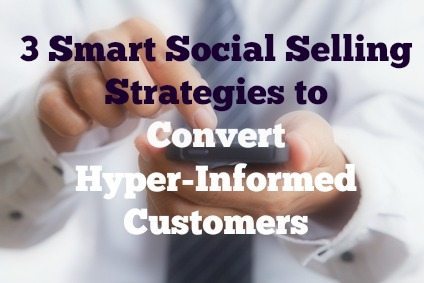3 Smart Social Selling Strategies to Convert Hyper-Informed Customers

Many businesses are lagging behind when it comes to meeting their potential customers’ needs online. Customers are switching between various sales channels, expecting seamless integration across touch points and through multiple devices. It’s a new challenge for businesses to control the customer experience in this context and customers are in the driver’s seat.
In a recent survey and study, ADLittle investigated dialogue ability in terms of the average response time for customer inquiries in the retail automotive sector. Most customers asked for 24/7 realtime response time and although dealers are mitigating the gap with an average response time of 9.2 hours, this is a significant mismatch when discussing possible ways to improve lead conversion and getting ready for the launch of online sales.
The study also showed that more than 70% of customers would appreciate getting advice at a location of their choice (ie: social channels). OEMs are still lagging behind customers’ needs: only half of them would offer alternative ways of consultation. It seems as though they’re not interested in a conversation around the sale of their product, unless it’s the forum they choose.
Today’s digital marketplace provides the information customers seek and it’s readily available anytime they choose. The key here is choice. Consumers are in the driver’s seat and if they choose to research their purchase online, then you and your salespeople need to meet them where they are, in the place they prefer.
Nearly 70% of surveyed customers spent more time online than offline for pre-purchase information gathering, with a relevant number researching online only. We’ve entered the age where the buyers’ purchase journey must be, to a certain extent, automatic and autonomous. Consumers are telling us this not by their words but by their actions. They go to great lengths to find out everything they can from anyone they know and trust before they interact with you.
The more you require in-person interaction during the research process, the more boundaries you create closing the sale.
Many businesses and their salespeople are not providing these expected dialogue capabilities, especially when it comes to the eventual closing of the sale. The current sales approach of one-way communication is not matching emerging customers’ needs.
Of course, this doesn’t mean that your sales channel or retail presence perishes, but it does mean that you have to shift your process to accommodate a new type of buyer. Here are 3 smart Social Selling strategies to convert the hyper-aware and hyper-informed consumer:
1. Make Social Selling Part of Your Sales Process.
Integrate Social Selling strategies throughout the purchase cycle and especially in the lead up to the sale.
- Make sure each salesperson can articulate their personal brand – their unique promise of value they bring to sales relationships.
- Ensure your salespeople are trained and proficient in the art of networking.
- Provide information and training on how to build a referral network on Social Media.
- Encourage salespeople’s participation in creating unique, helpful content for your business’ marketing channels.
2. Leverage Your Expertise. Provide Outside-the-Box Information that Attracts Buyers and Fosters Referrals.
Customers are ninjas now. Since they spend the bulk of their research time online, it’s your job to make sure they get the right information in all the places they’re searching for it. You already have a wealth of ideas within your organization. Employees on the front lines with your customers know the information they’re seeking. Employees know the questions customers aren’t asking but need to know. The goal is to be helpful. The 5 most valuable topics to address in your Social Selling strategies are:
- Cost/Price questions
- Problems/issues/concerns questions
- Versus/comparison questions
- “Best” questions
- Review/opinion-based questions
As you and your salespeople become proficient in creating and publishing content, people within the network will notice. Quality content fosters trust and this is perhaps the single most valuable component of Social Selling. Trustworthy information from within a trusted network allows you to cultivate leads.
3. Listen, Monitor and Analyze Conversations You’re Having and Not Having with Prospects.
One of the smartest Social Selling strategies is masterful networking. The key to effective networking is forming relationships based on trust in an atmosphere of generosity and selflessness. Set up a system to generate the largest possible number of high-quality referrals from as many sources as possible using your content as the catalyst. Use analytics to discover your wins and identify the places where you missed the boat.
“Giver’s Gain” is the world’s most successful organizational principle and it’s the cornerstone to Social Selling. As a business or as a salesperson, providing value to relationships allows you to leverage them for sales and referrals. Personal and commercial relationships have merged via Social Media. Use your downtime to cultivate relationships.
Author information
The post 3 Smart Social Selling Strategies to Convert Hyper-Informed Customers appeared first on Kruse Control Inc.


